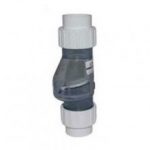The humble check valve is one of the most important components of any pumping system or fluid moving application. The simple design belies its critical nature. Put simply, the check valve is the first line of defense against backflow which can cause serious problems for your pump and pumping system.

Backflow is the motion by which water, under the influence of gravity, flows back down or through the pipe, opposite the direction it originally traveled. Remember that most pumps operate depending on the amount of water the pump needs to move at a given time. If water continually flows back into the pump’s basin, the pump will turn on and off continuously. This will lead to improper pump cycling and eventual burnout. Imagine that your sump pump fails and you have a flooded basement – it could be avoided with a proper check valve.
Swing Check Valve
Check valves come in a variety of types and designs. The most basic design is the swing check valve. The swing check valve has two ports, one where fluid enters and one where fluid leaves. A single disc-shaped flap attached to one spring-loaded hinge sits roughly in the center of the valve. Thanks to the hinge design, the flap can only open in one direction. Fluid pushes the flap and flows through the opening.
The cracking pressure is the minimum amount of pressure required to push open the flap. Reseal pressure is the pressure point at which there is no indication of flow, while back pressure is the difference between the pressure at the inlet and outlet ports.

The benefit of the swing check valve model is that it allows a full, uninterrupted flow of fluid. The simple design means that the cracking pressure required is less than other valve types. As pressure decreases, the valve door closes. No extra accessory or power supply is needed. Swing check valves are also plentiful in supply and of low price.
The downside of the swing model is that the continuous shutting and opening of the door flap can cause premature wear and tear. The slamming motion can also lead to excessive noise. Some swing check valves do come with a non-slam feature that regulates how the valve closes. PHCC Pro Series sells a Klunkless model with an adjacent chamber that absorbs air and eliminates noise.

Installing a Check Valve
Most swing check valves have an arrow on the casing that indicates the direction that the water or fluid should flow. If not, use some simple common sense: see which direction the flap opens. Install the valve so that the flap opens away from the pump.
If possible, install the check valve so that it is configured in a horizontal rather than vertical position. If the valve is vertically aligned, waste, particulates and other solids can accumulate on top of the valve door, hindering its operation. Pump Products experts also recommend using a valve with a quick disconnect coupling or union on either side called a fernco, no hub or slip joint, such as the Zoeller 30-041. The valve can be disconnected if any maintenance ever needs to be performed (as opposed to cutting through the pipe).
Other Types of Check Valves
The swing check valve is the most common type of check valve, particularly for home water and wastewater systems. There are other types of check valves however, and each has its own benefits and drawbacks. A diaphragm check valve uses a rubber diaphragm to seal the valve. Ball check valves contain a ball with a through valve. When the pressure above the ball exceeds the pressure below the valve seat, the ball rests in the seat, creating a seal to prevent backflow.
Whatever check valve you choose for your pumping system, always remember to size the valve properly for your specific application.






[…] ← Previous […]
[…] water traveling from a pump through a pipe. At some point, the water will reach a valve, such as a swing check valve. If and when the flap on that check valve snaps shut abruptly, the water that has not yet passed […]